|
|
 |
 |
| Making of an Image |
|
|
The life of an image begins with the deity, who manifests himself or herself within the image. With "self-originating" (swayambhu) images, there is no human intervention involved in creation; it is the event of discovery that is key to the human recognition and celebration of a sacred image, when a particular natural form or object is found to be imbued with divine presence. A human-created image begins its life not just when it takes concrete form, but also with the human intention to create the divine object and with the full realization of the divine within the object at consecration.
As the scholar of South Asian art and religion Richard Davis has noted in his book Lives of Indian Images, "There is never a time when the image exists as an unconsecrated object": God is present even in the raw materials used to create the image. During the fashioning of an image of God, the inherent divine presence is enhanced and focused. The process culminates in the installation of the image in the temple and the final consecration, which fully bring the image to life.
The process of divinization begins with the fabrication of the image. Materials are chosen with careful attention. The formation of the physical image begins with a ritual initiation: both priest and artisan are key to the process. As the process continues, the priest usually retains an important role, blessing the image at intervals and ensuring its ritual sanctity throughout.
The artist, especially when creating more formal images, must follow strict iconographic conventions; these are defined in texts such as the Shilpashastras, which dictate the forms of buildings and images. Various media, including stone, bronze, clay, and wood, are used to create three-dimensional images. For images integrated within a larger architectural structure, stone is common. Bronzes (Figure 1) are formed through the lost-wax process (Figures 2 and 3). First, a wax form is created that is identical to the final bronze image. This model is covered in clay to create an impression of the image, and the clay is fired, melting the wax, which runs off through holes and is lost -- hence the term "lost wax." This leaves the artist with a hollow mold, into which the molten metal is poured. The resulting object is then freed from the clay, often to be refined and smoothed. The bronze has come into being.
The central images in the Jagannath temple in Orissa are made of wood, and represent Krishna (as Jagannath, or "Lord of the world") and his brother and sister. Unlike most central images in temples, they are impermanent -- repaired and repainted every year and replaced every twelve to nineteen years -- and every year during the chariot festival, the three icons are brought out, set on massive floats, and taken in procession through the streets (Figure 4), another practice that is not usual for central shrine images. The images are created and recreated according to a prescribed pattern. In the year that they are due to be replaced, the renewal ceremony (called navakalevara) begins six weeks before the chariot festival. The renewal ceremony has many stages, which are presided over by non-Brahmin priests -- another unusual feature, as Brahmins normally control the ritual life of images. The ceremony includes the ritual search for the wood to be utilized, the carving of the images in secret by non-Brahmin priests, the consecration of the new icons, the burial of the old ones, and their mourning by the priests, who are considered blood relatives of the images. After the final preparation of the images, during which the three non-anthropomorphic icons are dressed in clothing as if they were anthropomorphic, their ongoing ritual life commences.
The images created for the many street and community festivals of the Hindu world are less formal, but as important as those created for installation in large temples. Large numbers of images of the Goddess are created for the Durga and Kali Pujas of Bengal, community-wide celebrations that feature the creation of temporary shrines and image processions (Figures 5, 6, and 7). These images are ephemeral: they are meant to be destroyed through submersion in a holy body of water at the end of the festival. Made of unfired clay and painted in bright colors, they reflect modern as well as traditional standards of representation.
The poster is also an important form of devotional art; posters of the Gods are found throughout the Hindu world and beyond (Figure 8). A popular art form in South Asia, posters portray not only the Hindu Gods, but also Sikh gurus, Muslim holy places, and heroes of the nationalist movement. Such posters make images of God accessible to those who cannot afford more formal three-dimensional images. They can be seen decorating stores, taxis, and buses in India today, as well as the walls of homes and temples. Poster-type representations of deities originated in the 19th century, a product of both the growing influence of modern Western painting conventions and the advent of offset printing technology in India. These images reflect modern and transnational aesthetics in their portrayal of God.
If an image is damaged, it cannot be utilized in devotional contexts. A new image must be commissioned, necessitating the continual production of images. A wide variety of images -- and artists to create them -- are required; some roles are traditional, while others are of a more recent vintage.
< previous next >
Top |
|
 |
 |
| Click for details |
 |
 |
 |
Fig. 1
|
 |
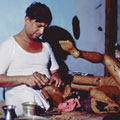 |
 |
Fig. 2
|
 |
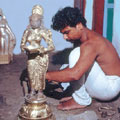 |
 |
Fig. 3
|
 |
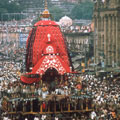 |
 |
Fig. 4
|
 |
 |
 |
Fig. 5
|
 |
 |
 |
Fig. 6
|
 |
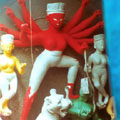 |
 |
Fig. 7
|
 |
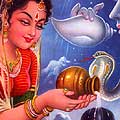 |
 |
Fig. 8
|
 |
|
 |


